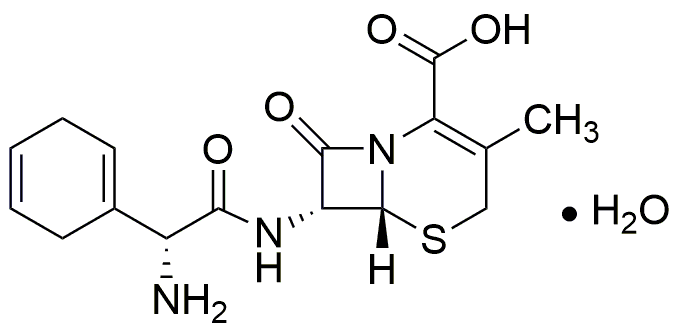Cephradine monohydrate is widely utilized in research focused on:
- Antibiotic Treatments: It is primarily used as an antibiotic to treat various bacterial infections, particularly in respiratory and urinary tract infections, providing a reliable option for healthcare professionals.
- Pharmaceutical Formulations: This compound is incorporated into oral and injectable formulations, ensuring effective delivery of medication, which is crucial for patient compliance and recovery.
- Veterinary Medicine: Cephradine monohydrate is also applied in veterinary practices to treat infections in animals, showcasing its versatility across different species.
- Research and Development: It serves as a model compound in pharmacological studies, helping researchers understand antibiotic mechanisms and resistance patterns, which is vital for developing new drugs.
- Quality Control in Manufacturing: The compound is used in quality control processes to ensure the efficacy and safety of antibiotic products, helping manufacturers meet regulatory standards.
General Information
Properties
Safety and Regulations
Applications
Cephradine monohydrate is widely utilized in research focused on:
- Antibiotic Treatments: It is primarily used as an antibiotic to treat various bacterial infections, particularly in respiratory and urinary tract infections, providing a reliable option for healthcare professionals.
- Pharmaceutical Formulations: This compound is incorporated into oral and injectable formulations, ensuring effective delivery of medication, which is crucial for patient compliance and recovery.
- Veterinary Medicine: Cephradine monohydrate is also applied in veterinary practices to treat infections in animals, showcasing its versatility across different species.
- Research and Development: It serves as a model compound in pharmacological studies, helping researchers understand antibiotic mechanisms and resistance patterns, which is vital for developing new drugs.
- Quality Control in Manufacturing: The compound is used in quality control processes to ensure the efficacy and safety of antibiotic products, helping manufacturers meet regulatory standards.
Documents
Safety Data Sheets (SDS)
The SDS provides comprehensive safety information on handling, storage, and disposal of the product.
Product Specification (PS)
The PS provides a comprehensive breakdown of the product’s properties, including chemical composition, physical state, purity, and storage requirements. It also details acceptable quality ranges and the product's intended applications.
Certificates of Analysis (COA)
Search for Certificates of Analysis (COA) by entering the products Lot Number. Lot and Batch Numbers can be found on a product’s label following the words ‘Lot’ or ‘Batch’.
*Catalog Number
*Lot Number
Certificates Of Origin (COO)
This COO confirms the country where the product was manufactured, and also details the materials and components used in it and whether it is derived from natural, synthetic, or other specific sources. This certificate may be required for customs, trade, and regulatory compliance.
*Catalog Number
*Lot Number
Safety Data Sheets (SDS)
The SDS provides comprehensive safety information on handling, storage, and disposal of the product.
DownloadProduct Specification (PS)
The PS provides a comprehensive breakdown of the product’s properties, including chemical composition, physical state, purity, and storage requirements. It also details acceptable quality ranges and the product's intended applications.
DownloadCertificates of Analysis (COA)
Search for Certificates of Analysis (COA) by entering the products Lot Number. Lot and Batch Numbers can be found on a product’s label following the words ‘Lot’ or ‘Batch’.
*Catalog Number
*Lot Number
Certificates Of Origin (COO)
This COO confirms the country where the product was manufactured, and also details the materials and components used in it and whether it is derived from natural, synthetic, or other specific sources. This certificate may be required for customs, trade, and regulatory compliance.


